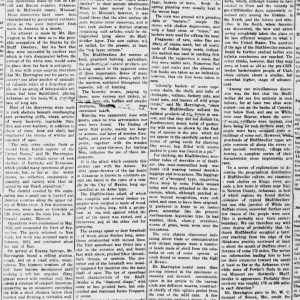calsfoundation@cals.org
M. R. Harrington (1882–1971)
aka: Mark Raymond Harrington
Mark Raymond Harrington was a pioneer in the field of archaeology in Arkansas. He researched Native Americans in Arkansas for the Museum of the American Indian, Heye Foundation (New York). This work brought him to Arkansas between 1916 and 1923. His two books published on these investigations, Certain Caddo Sites in Arkansas (1920) and The Ozark Bluff-Dwellers (1960), have had a lasting influence on the development of archaeology in Arkansas and in the southeastern United States.
M. R. Harrington was born in Ann Arbor, Michigan, on July 6, 1882, to Rose Martha Smith Harrington and Mark Walrod Harrington, astronomer, meteorologist, and then director of the University of Michigan’s Detroit Observatory. The family later lived in Washington DC; Seattle, Washington; and Mount Vernon, New York. Harrington’s early interest in Indians and the discoveries of ancient sites and artifacts near his home in New York led him to F. W. Putnam of the American Museum of Natural History. While still a teenager, Harrington worked for Putnam, excavating sites around New York City. He received his bachelor’s and master’s degrees in anthropology from Columbia University in New York, writing his 1908 master’s thesis on Iroquois archaeology.
Harrington met and worked for George Gustav Heye in collecting ethnological and archaeological artifacts even before Heye transformed his extensive collection into the Museum of the American Indian. In February 1916, Harrington came to Fulton (Hempstead County) to lead an archaeological expedition in the Red River valley for the newly formed museum. Flooding on the Red River turned the expedition towards the interior of southwestern Arkansas, and the region’s rich history turned an anticipated six-week field season into twenty months. Harrington’s team explored Caddo mound and village sites in Hempstead, Howard, and Garland counties. Harrington then published descriptions of the sites, interpreted sequences of building and mound construction, and illustrated representative artifacts in Certain Caddo Sites in Arkansas. Based on his excavations near Hot Springs (Garland County) Harrington presented a sequence of ancient Indian cultures in southwest Arkansas, with an earlier group (in what is now termed the Archaic Period) preceding the more recent Caddo Indians (in the Mississippian Period). Harrington drew on historical descriptions of Caddo Indians from the sixteenth, seventeenth, and eighteenth centuries, as well as his archaeological finds to describe the culture and lifeways of ancestral Caddo Indians in southwest Arkansas.
Harrington’s work in northwest Arkansas began after the Museum of the American Indian purchased a collection from W. C. Barnard of Missouri, including Indian basketry and other organic objects preserved by the unusually arid conditions of some Ozark Mountain rock shelters. Harrington directed an expedition to the area for the museum in 1922 and 1923. He investigated numerous rock shelters in Benton, Carroll, Madison, Marion, and Newton counties in Arkansas and in McDonald County in Missouri.
Harrington published an article on this work in American Anthropologist in 1924, but his book on the subject, The Ozark Bluff-Dwellers, was not published until 1960. Harrington’s interpretation of the archaeological material as representing an earlier “Ozark Bluff-dweller” culture and a later “Top-layer” culture has been revised by modern archaeologists. Recent research indicates that Ozark rock shelters were occupied during the Archaic, Woodland, and Mississippian periods, and that these people lived in a variety of settlements, not just bluff shelters. However, Harrington’s research showed the range of plant and animal foods—both wild and cultivated—that made up the diet of ancient Indians in Arkansas. Bones of deer, bear, and smaller animals like turkey, as well as tools like spears and bows and arrows, indicated that hunting was important, and preserved plant remains and agricultural tools showed that corn, beans, squash, sunflowers, and other small-seeded plants were grown for food. Harrington’s descriptions of preserved baskets, clothing, and other objects of native manufacture also prompted Samuel C. Dellinger, curator of the University of Arkansas Museum from 1925 to 1960, to excavate Ozark rock shelters during the 1930s.
From 1919 to 1928, Harrington also led expeditions in Tennessee, Nevada, and Texas for the Museum of the American Indian before moving to Los Angeles, California, to become the Director of Research and later curator of the Southwest Museum. He focused his archaeological investigations on Nevada and California for the remainder of his career. In 1956, Harrington was awarded an honorary doctorate from Occidental College in Los Angeles.
Harrington’s archaeological research described numerous sites and artifacts and furnished clues to the great time-depth of Indian life in Arkansas. While his work added objects to museum collections that are now part of the Smithsonian Institution’s National Museum of the American Indian, his motives were scientific research and the expansion of knowledge.
M. R. Harrington died on June 30, 1971, in Los Angeles. He is buried in San Fernando Mission Cemetery, Mission Hills, California.
For additional information:
Bluff Shelters of the Arkansas Ozarks. Arkansas Archeological Survey. http://archeology.uark.edu/ozarkbluffshelters/ (accessed July 11, 2023).
Harrington, M. R. Certain Caddo Sites in Arkansas. Indian Notes and Monographs. New York: Museum of the American Indian, Heye Foundation, 1920.
———. “The Ozark Bluff-Dwellers.” American Anthropologist 26 (January–March 1924):1–21.
———. The Ozark Bluff-Dwellers. Indian Notes and Monographs 12. New York: Museum of the American Indian, Heye Foundation, 1960.
———. “Reminiscences of an Archeologist.” The Masterkey 36, no. 2 (1962):138–142.
Harrington, Marie. On the Trail of Forgotten People: A Personal Account of the Life and Career of Mark Raymond Harrington. Reno, NV: Great Basin Press, 1985.
Stoltman, James B. “The Southeastern United States.” In The Development of North American Archaeology, edited by James E. Fitting. Garden City, NY: Anchor Books, 1973.
Mary Beth Trubitt
Arkansas Archeological Survey





M. R. Harrington did work in Westchester County, New York, for the Heye Foundation at what is now the Croton Nature Center. There was also a lecture on his excavations at the Louis A. Brennan Chapter of the New York State Archaeological Association. Harrington also wrote The Rock Shelters of Armonk, New York.